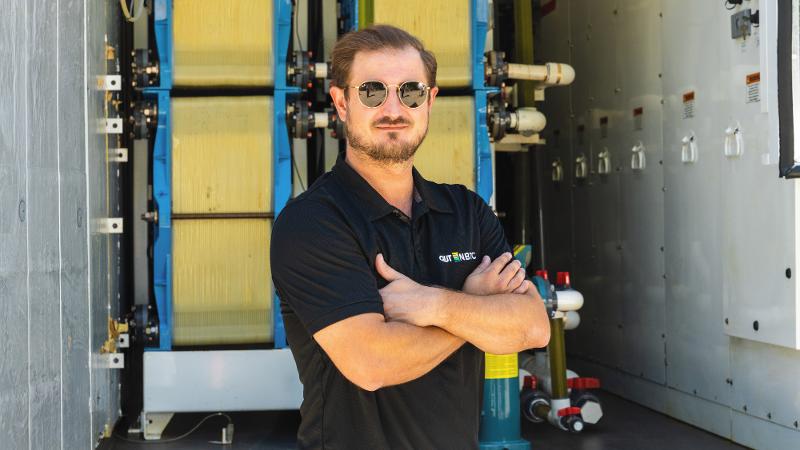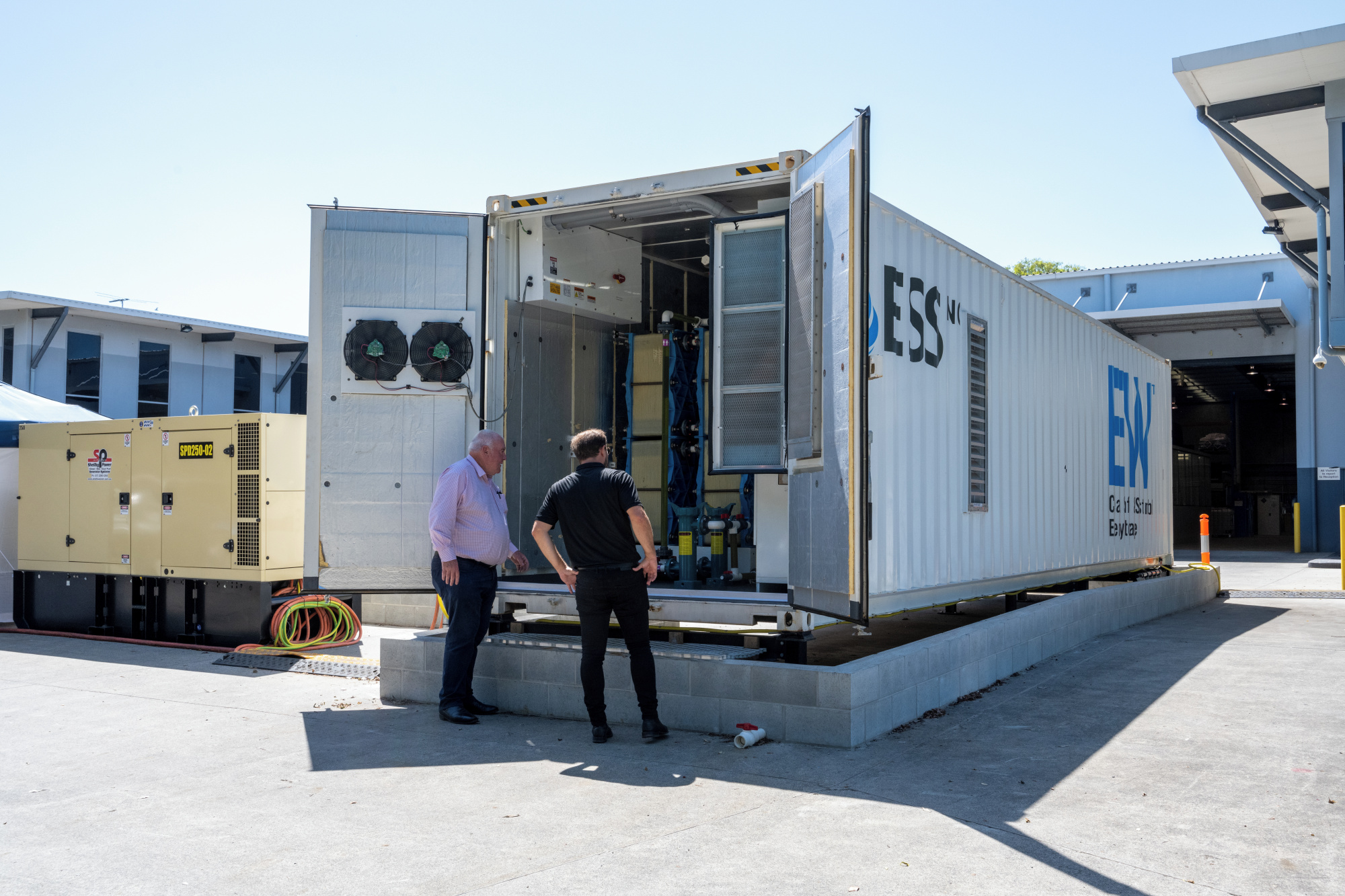
Researchers at the QUT-operated National Battery Testing Centre (NBTC) have commissioned the biggest large-scale iron flow battery - and the first of its kind - outside of the United States.
QUT is collaborating with Energy Storage Industries - Asia Pacific (ESI) and the Future Battery Industries Cooperative Research Centre (FBICRC) to enable large-scale energy storage solutions to help meet clean energy targets set by state and federal governments.
The Queensland Government’s Energy and Jobs Plan - released in September 2022 - sets a target of 70% renewables in the energy grid by 2032.
Deputy Premier Steven Miles said the Queensland Energy and Jobs Plan was already creating new jobs in new industries like battery manufacturing.
“Large-scale iron flow batteries are the cutting edge of the energy revolution, and that innovation is happening right here in Queensland thanks to the support of the Palaszczuk Government,” the Deputy Premier said.
“As we invest in more solar and more wind, the demand for large-scale batteries and storage will increase to ensure Queensland’s energy is reliable and affordable, these new batteries are perfect to support our energy grid.
“Testing the biggest large-scale iron flow battery at QUT’s Banyo facility is another step toward meeting our renewable energy targets.
“Construction is also underway in Maryborough for Australia’s first, large-scale iron flow battery manufacturing facility, being development by ESI.
“Bringing manufacturing home is a key part of the Queensland Energy and Jobs Plan, we have the opportunity to design and manufacture these batteries here in Queensland by Queenslanders.”
NBTC Project lead Dr Joshua Watts from the QUT Faculty of Science said effective long-duration energy storage - such as flow batteries - is necessary to meet those targets and to support the intermittency of renewable energy such as wind and solar.
A flow battery contains two chemical solutions, separated by a membrane, with electricity stored and released through changes in the oxidation state of metal ions dissolved in solution.
“This particular battery shows great potential in providing large-scale long-duration energy storage solutions to store energy for distribution when the wind is not blowing and the sun is not shining,” Dr Watts said.

“It’s not the type of battery you would buy for the backyard, but more targeted toward large-scale solar and wind farms, or new community developments where they're looking to build in more localised energy generation and distribution networks.”
The ‘Energy Warehouse’ iron flow battery being commissioned and tested at the NBTC is a 12-metre-long containerised system and is designed to be used for large-scale energy generation and distribution support for the electricity grid.
“Energy Warehouse systems have the potential to store solar energy generated by residential solar arrays to assist with the management of excess energy that the current electricity transmission infrastructure can't handle,” Dr Watts said.
He said lithium batteries were more compact, but the cost of scaling lithium batteries for long-duration storage applications can potentially be an issue for large-scale applications.
Iron flow batteries are better suited for large-scale applications, offering ease of scalability for long-duration energy storage applications.
“Iron flow batteries are well suited for long-duration applications due to the nature of the energy storage mechanism, which is achieved through dissolved metal salts in aqueous solution. So, you just increase the electrolyte volume, and you increase the capacity. You only need to make the tank bigger,” Dr Watts said.
Other advantages of iron flow batteries are that they are environmentally benign, fully recyclable and offer a potential lower cost per kWh for long-duration storage applications.
Dr Watts said the potential for local manufacturability of the iron flow systems is high because they use simplified componentry. They mainly comprise PVC pipes, water pumps and fiberglass tanks assembled in a 12-metre container.
“There's potential then to reskill workers moving out of the coal-fired power station industry who have similar skill sets in maintaining plant equipment.”
Dr Watts said iron flow batteries have an advantage when it comes to enlarging, repurposing or recycling.
“Iron flow batteries utilise a weakly acidic iron chloride solution which is non-toxic, simplifying the refurbishment and recycling process for these systems,” said Dr Watts.
The NBTC, at Banyo on Brisbane’s northside, is one of the flagship projects funded by the FBICRC grant program, and the first facility of its kind in Australia. It is one example of QUT’s nation leading efforts in accelerating new energy storage solutions in support of Australia’s decarbonisation efforts.
“The NBTC will reduce costs by allowing local battery system manufacturers to test and certify their products to Australian and international standards right here. Previously companies would rely on overseas testing facilities in the US, Japan and Europe,” said Dr Watts.
“Activating that local support will enable local manufacturers and industry to get their products to market quicker and at reduced cost,” Dr Watts said.
“Enabling domestic manufacturing of battery cells and systems is critical to realising our clean energy targets, and with the current global demand there will definitely be an export market for these products as well,” Dr Watts said.
“But we're also working with partners to develop safer systems, safer materials that go into cells, and safer control methodologies.”

Dr Watts and his team have recently been demonstrating the iron flow battery’s features to a range of Government Sponsored Enterprises (GSEs) and private energy companies at the NBTC.
“And we'll be going through - over the next three months or so - a rigorous testing regime in collaboration with potential off takers to test the battery under different use conditions to get these batteries out into the wild supporting the energy grid as soon as possible,” Dr Watts said.
“The next step is to support ESI in pilot manufacturing efforts to establish onshore large-scale manufacturing of the systems to meet local supply.”
The Queensland Government’s recently released battery industry opportunities for Queensland discussion paper has highlighted that a broad range of mature players across the entire battery value and supply chain currently call Queensland home, with a lot of exciting opportunities on the horizon to value add and deliver a strong local battery economy supporting both domestic and export markets.
“QUT is keen to continue its support of ESI and other local battery industry partners, and with the extensive roadmap and support provided by the Queensland Government, broaden our collaborative efforts to continue to deliver real-world solutions in support of meeting our clean energy and sustainability targets,” Dr Watts said.
Energy Storage Industries - Asia Pacific (ESI) Managing Director Stuart Parry said the commissioning was a significant step towards securing Queensland’s future as a renewable energy superpower.
“Commissioning of this leading-edge technology puts the state on track to accelerate renewable energy storage as part of the Queensland Energy and Jobs Plan to address climate change.
“The National Battery Testing Centre has already demonstrated the potential of iron-flow technology, and this will be the first of many batteries that will support jobs and provide reliable energy across the state.
“Thanks to QUT for their invaluable contribution, the Future Battery Industries Cooperative Research Centre for the funding they provide to the facility and the Queensland Government for their support,” Mr Parry said.
Media contact:
Pat Whyte, QUT Media, 07 3138 1150, patrick.whyte@qut.edu.au
After hours: 0407 585 901, media@qut.edu.au


